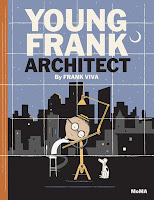I’m thrilled to be joining the picture book 10 for 10 fun again this year! I enjoy the challenge of creating a meaningful list for my self and others, as well as reading all the wonderful lists posted by the community.
The makerspace movement has greatly impacted my role as a school librarian within the past year. I’ve created a list of picture books to support staff and students as they engage on makerspace activities and challenges.
1. The Most Magnificent Thing by Ashley Spires
This book is about a young girl who enjoys creating things and decides to build something truly special. So, after drawing diagrams, hiring an assistant, and collecting materials, she establishes her sidewalk workshop. But, alas, bringing vision to fruition isn’t easy. From her efforts, children see the importance of planning, gathering supplies, building, and not giving up when a good idea doesn't initially work out. I tell my students this is a “maker mindset.” Try your hardest and don’t give up, even when things are confusing, difficult, or frustrating.
2. What to do With a Box by Jane Yolen & Chris Sheban
This story is about all the things that a cardboard box can be. It can be a library, a sailboat, or a race car. This is a great book to kick off the Cardboard Challenge’s Global Day of Play in October. I love reading this book and following up the video from Cane’s Arcade. They are a powerful combination to motivate and inspire students to imagine and create.
3. Hello Ruby: Adventure in Coding by Linda Liukas
This tells the story of Ruby who is determined to solve any problem. This book is a great introduction to programming and coding concepts like computational thinking, how to break big problems into small ones, create step-by-step plans, look for patterns, and thinking outside the box. It can be accompanied with and coding activities within your makerspace like hour of code, code.org, and scratch.
4. Franky by Leo Timmers
This book is great to encourage makers to dream big, use their imagination, and embrace engineering skills. Sam is obsessed with robots. He’s convinced they live on another planet in outer space. His family laughs at his idea. He builds his own robot, keeping it hidden from his family for fear of being ridiculed. Eventually, his robot friend is rescued by outer space robots to return to his home - leaving his family in shock! This book teaches maker students to dream big, don’t listen to others, and believe in your vision.
5. Rosie Revere, Engineer by Andrea Beaty
This is a story of creativity and perseverance, both important to successful tinkering in a makerspace. Rosie Revere constructs great inventions, but she gets laughed at and becomes afraid to show them to others. Then she finds encouragement from a great-great aunt who teaches Rosie to celebrate both her failures and successes. I love the overall message that projects that don’t work initially shouldn’t be discouraging. Things may not always go as planned, but celebrate your successes and learn from failure.
6. Marvelous Mattie: How Margaret E. Knight Became an Inventor by Emily Arnold McCully
This is a great book to inspire girls to embrace engineering, STEM, and makerspace activities. Mattie lived during a time when it was believed that women couldn’t understand the complexities of mechanical equipment. Yet she sketched and created inventions to help her family, mill workers, and even designed a machine to fold square paper bags like the ones we still use today. It’s a great message encouraging girls to dream big, create, and invent.
7. Young Frank Architect by Frank Viva
Makers need to think outside the box and look at things differently. This is the story of a young and old architect, both named Frank. Young Frank designs and creates a chair from toilet paper rolls and a curvy model of a skyscraper. Old Frank is a traditionalist and says Young Frank’s creations are incorrect. Until they visit the Museum of Modern Art and Old Frank discovered unique creations and begins to appreciate Young Frank’s creations. This book celebrates the ideas of young designers and encourages them dream and think creatively.
8. What Do You Do With An Idea? by Kobi Yamada
I’ve taught maker students the design process and encouraged them to start with an idea. This book is a wonderful accompaniment to this lesson. It inspires students to take an idea - whether little, big, odd, or difficult - and give it space to grow. With a little encouragement, an idea can become something amazing.
9. Awesome Dawson by Chris Gall
Everything can be used again! That’s Dawson’s motto. He takes trash and creates cool inventions like a hot tub on wheels for a motorboat. Until one day, he creates a machine to do his chores but it goes on a rampage instead. This book is great to encourage students to recycle junk and repurpose everyday items - a common theme in a makerspace.
10. Different Like Coco by Elizabeth Matthews
Sewing was a very popular activity in my makerspace last year. This book about Coco Chanel will inspire young fashion designers both experienced and novice. Coco designed comfortable clothing for women of all classes. Soon a new generation of independent working women craved her sleek and practical designs. Coco was always different, and she proved that being different was an advantage - a wonderful message for young makers, creators, and designers.













